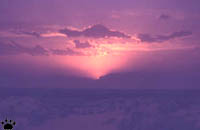
Sunrise over the Great Plains, New Mexico.
Prairie-chicken and sage grouse
| Grouse (Tetraonidae) are unique among birds:
it's the only family to have evolved in the boreal forests of Eurasia and North
America. For unknown reasons, Eurasian grouse still mostly live in the forests
(although two species used to occur in steppe woodlands, and ptarmigans prefer
tundras), while in North America they successfully colonized grasslands and deserts.
Five out of eleven American grouse now live south from the forests. |
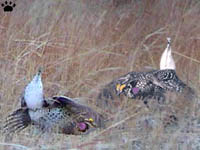
Grouse leks are one of the most interesting things
to see in the North in spring. Some of them exist
for centuries. Males dance and occasionally fight
there. Nebraska National Forest, Nebraska.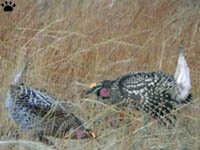
Sharp-tailed grouse visit leks from late February
to early June, later in the North. They start
dancing before sunrise, and continue for 2-4
hours. Nebraska National Forest, Nebraska. |
All five have communal dancing grounds,
or leks, including the most widespread species, the sharp-tailed grouse
(Tympanuchus phasianellus). Six subspecies of this beautiful bird inhabit
all kinds of open spaces from interior Alaska to Quebec,
and from Yukon to Colorado. Sharp-tailed grouse has lost a lot of habitat, especially
in the southern part of its range, but is still common in many areas. Like all
other "open-space" grouse, it's a shy bird, difficult to see away from
leks. |
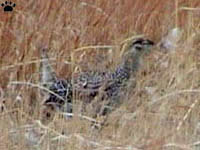
Females usually attend leks only at the height of
the breeding season. They mostly stay at the
periphery of the lek, and serve as sentinels.
Nebraska National Forest, Nebraska.
In all five "open-space" grouse species of North
America, males have inflatable vocal sacs -
"bubbles" of skin on the neck, serving as sound amplifiers. Nebraska National
Forest, Nebraska. |
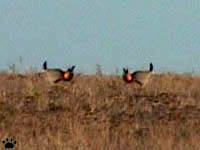
Prairie-chicken leks are easy to locate: their
booming "oo-loo-woo" calls are louder than low
"oo-woo" calls and cackling of sharp-tails, and
can be heard miles away. Grand Island, Nebraska.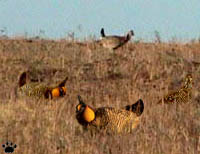
Lekking includes a lot of "booming", running,
jumping in the air, and chasing each other, but
very little fighting. The choice of mates is up
to the females. Grand Island, Nebraska. |
The two species of prairie-chicken
were less lucky. Greater prairie-chicken (T. cupido) has lost 70% of its
historic range. The eastern race, known as heather hen (T. c. cupido),
which once inhabited meadows and prairies of northeastern United States, is now
extinct. Texas race (T. c. attwateri) numbers less than a thousand. The
western subspecies (T. c. pinnatus) is doing slightly better - it still can be
seen in many parts of the Great Plains, especially in
Kansas, Nebraska and South Dakota. |

In addition to vocal sacs, males of all five species
have decorative feathers. Almost invisible most of
time, they completely change a bird's appearance
during lekking. Grand Island, Nebraska. 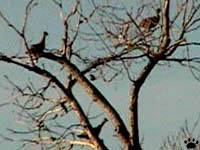
Although prairie-chicken and sharp-tailed
grouse
are birds of open areas, they use trees as shelter, lookouts, and source of food
- buds and seeds.
Attwater Prairie-Chicken Reserve, Texas. |

Lesser prairie-chicken are smaller and paler.
Males have pink, not golden, vocal sacs. Their
calls are higher pitched. They prefer more arid
habitats. Comanche Nat'l Grassland, Colorado.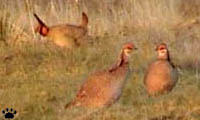
Prairie-chicken leks are usually active from late
March to late May. In some areas they form
mixed leks with the sharp-tails, and hybridize
frequently. Comanche Nat'l Grassland. |
Lesser prairie-chicken (T. pallidicinctus)
is more local. It only occurs in a small area of shortgrass prairie in Oklahoma
and adjacent states - less than 10% of its original range. The reasons for prairie-chicken
decline include habitat loss, pesticide use, overhunting, overgrazing, disturbance
at leks, and competition with introduced ring-necked pheasant (Phasianus colchicus).
Pheasant hens sometimes overtake prairie-chicken nests. |
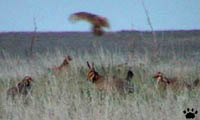
Leks are usually located in open areas, where the
birds can easily spot approaching predators. Such
places can be scarce in agricultural landscapes,
and easily disturbed. Comanche Nat'l Grassland.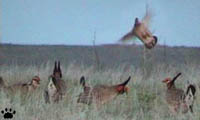
Many ancient leks have been abandoned due to
disturbance by birdwatchers. Always arrive at a
lek before midnight, stay in a car or a blind, and
be absolutely quiet. Comanche Nat'l Grassland. |
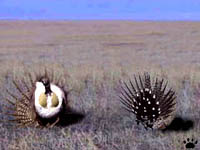
Sage grouse leks are even more spectacular than
those of smaller grouse species. They are active
March to May, when high desert mornings are
often freezing. Biscar Wildlife Area, California.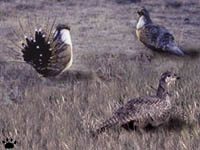
Males produce deep, bubbling sounds, that carry
very far and can be heard from miles away. Unlike prairie-chicken. They hold individual
territories
on leks. Biscar Wildlife Area, California. |
Greater sage-grouse (Centrocercus
urophasianus) are twice as large as prairie-chicken (which doesn't prevent
them from hybridizing occasionally). They inhabit the Great
Basin and other sagebrush deserts from extreme southwestern Canada to eastern
California. Recently, American ornithologists were subjected to a shocking surprise:
some populations of this well-known bird were found to be a separate, very distinct
species, Gunnison sage grouse (C. minimus). |
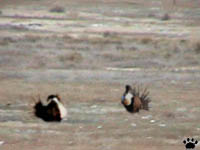
Gunnison sage grouse are smaller and darker than
greater sage grouse, with a different array of
decorative figures. Their dances and calls are also
very different. Waunita Hot Springs, Colorado.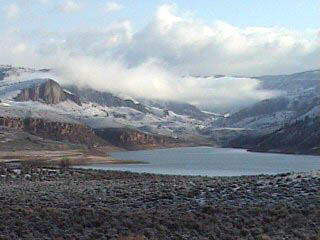
This rare species is confined to a few isolated
intermontane valleys of the Southern Rockies.
Currently, the largest surviving population is in
Gunnison Valley of Central Colorado. |
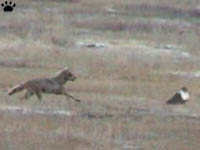 |
 |
 |
| Grouse nests and chicks suffer a lot
from predation and bad weather, but adult birds have few natural enemies. They
are not easy to catch, even at leks. Waunita Hot Springs, Colorado. |
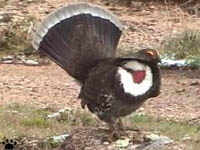
Blue grouse inhabits mountain forests of the
West. Black Canyon of the Gunnison, Colorado.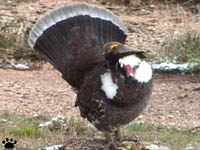
Like most forest grouse, blue grouse doesn't
have
group leks. Instead, males dance alone.
Black Canyon of the Gunnison, Colorado.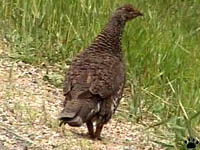
Like their subarctic relatives, the spruce
grouse
(Falcipennis), blue grouse are very tame.
Spanish Peaks, Colorado. |
Despite looking so differently, all
five species of "open-space" grouse are probably closely related. Their
vocal sacs are unique among gallinaceous birds. The only other species to have
them is the blue grouse (Dendragapus obscurus), a common bird of the Cascade
the Rocky Mountains from Yukon to New Mexico. It is apparently an evolutionary
link between "open-space" grouse and their forest relatives. It is also
known to hybridize with sage and sharp-tailed grouse in the wild. All
grouse species can hybridize in the wild,
and all look very similar, except for adult males
with their decorative plumage. My personal opinion is that they should
all be merged into a single genus, Tetrao. |
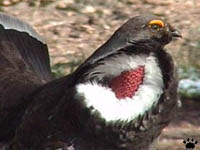
Blue grouse' vocal sacs are colorful: purple in
the
Rockies birds, and golden in the Cascades race.
Those vocal sacs produce booming sounds, but
they are far less loud than in prairie species.
Black Canyon of the Gunnison, Colorado.
This lack of fear can get them into trouble in
areas
where they are hunted or have to
cross roads. Spanish Peaks, Colorado. |
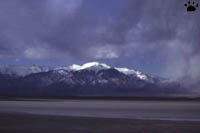
Greater sage grouse habitat, Nevada.
Home
|